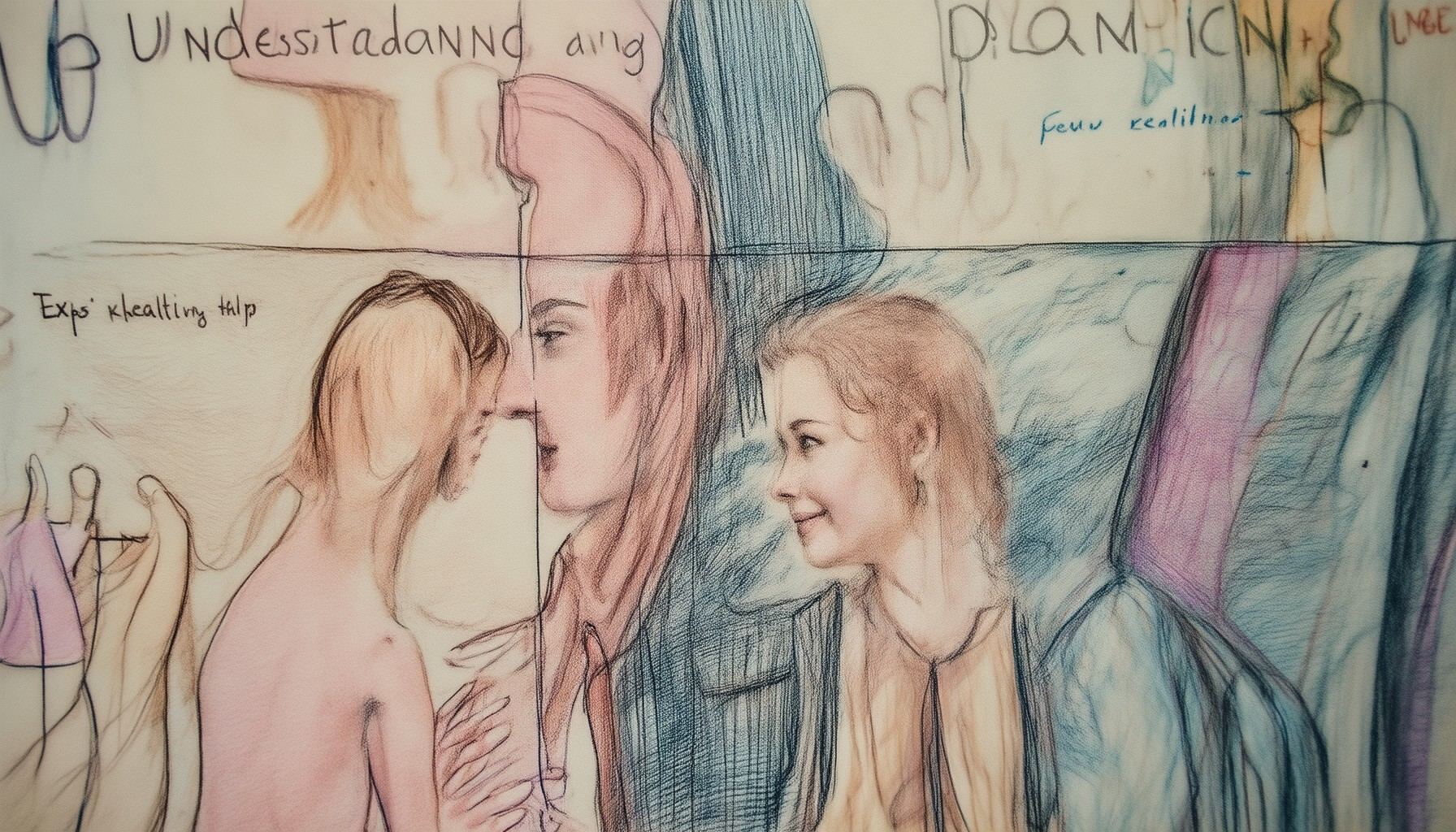Understanding relationship dynamics is crucial for building meaningful connections and navigating life’s complexities. Relationships evolve over time, shaped by a unique interplay of emotions, communication styles, and shared experiences. Whether you’re exploring the early stages of romance, weathering tough times, or seeking ways to strengthen your bond, grasping the nuances of relationship dynamics is essential. This guide delves into the various facets of relationships, offering insights into the different types, common challenges, and keys to fostering healthy and enduring connections. From identifying the signs of true love to understanding the four E’s of relationships, this exploration will equip you with the tools to analyze and enhance your own relationship dynamics, ensuring stronger interactions and deeper emotional bonds.
Key Takeaways
– Identify the four primary types of relationships: romantic, familial, friendly, and professional, each defined by unique dynamics and purposes.
– To build lasting connections, focus on the four E’s: Experience, Experiment, Educate, and Engage, fostering growth, resilience, and mutual respect.
– Look for these signs of true love: consistency, support, open communication, boundary respect, shared joy, and unwavering commitment.
Understanding Dynamics in Relationships
Dynamics in a relationship refers to the complex interplay of emotional, psychological, and social forces that define how two or more people connect and interact.
- Emotional Connection: The deep bond formed through shared experiences, feelings, and mutual understanding.
- Communication Patterns: The ways in which people exchange information and express their thoughts and emotions.
- Mutual Respect: The recognition of each individual’s worth and the valuing of their unique qualities and perspectives.
- Trust Building: The gradual establishment of confidence in one another’s reliability and integrity.
The dynamics of a relationship are influenced by several key factors:
Key Considerations
- Power Dynamics: The balance of influence, control, and decision-making between partners.
- Role Dynamics: The division of responsibilities and the shifting roles each person plays over time.
- Conflict Resolution: The mechanisms used to address disagreements and maintain harmony.
- Cultural Influences: The impact of cultural norms and values on what is perceived as healthy or dysfunctional behavior.
Understanding these dynamics is crucial for building and maintaining healthy relationships. By recognizing and addressing the complexities involved, individuals can foster stronger connections and navigate challenges more effectively.
What Does a Healthy Relationship Dynamic Look Like?
A healthy relationship dynamic is characterized by mutual respect, open communication, and a balanced partnership that fosters growth and understanding. Here’s a breakdown of key components:
1. Mutual Respect
Respect forms the foundation of any healthy relationship. Both parties acknowledge each other’s individuality, opinions, and boundaries. This means valuing each other’s strengths and weaknesses without judgment.
2. Open Communication
Effective communication is essential. Healthy relationships thrive on honesty, vulnerability, and active listening. Partners feel safe expressing their thoughts and concerns, knowing they won’t be criticized or dismissed.
3. Trust
Trust is the cornerstone of a healthy relationship. It’s built over time through reliability, integrity, and consistency. Without trust, it’s challenging to establish a strong emotional connection.
4. Balance
Healthy relationships are equal partnerships, not power struggles. Both individuals contribute equally, making decisions together without fear of manipulation or control.
5. Emotional Support
Providing emotional support helps sustain the relationship during tough times. Partners comfort and uplift each other, creating a sense of safety and belonging.
6. Shared Goals
Aligning on shared values and objectives strengthens the bond. Whether it’s financial stability, personal growth, or family aspirations, working towards common goals adds purpose to the relationship.
7. Flexibility
Adapting to changes is crucial. Healthy relationships evolve over time, embracing growth and change while remaining committed to each other’s well-being.
8. Growth
Encouraging personal and mutual development keeps the relationship dynamic. Supporting each other’s aspirations and learning opportunities fosters a thriving, long-lasting connection.
For more insights and practical tips, explore Chris and One’s resources on building and maintaining healthy relationships: Chris and One .
The Hardest Phases of a Relationship
A relationship goes through several stages, each presenting its own set of challenges. While every couple experiences difficulty differently, certain phases tend to be universally recognized as particularly challenging. Below are some of the hardest phases of a relationship:
- The First Fight :
The initial phase of a relationship often involves navigating unspoken emotions and learning how to handle conflict. Fights during this stage can be particularly tough because both partners are still getting comfortable with expressing their needs and boundaries. How they handle these early disagreements can significantly shape the foundation of the relationship. - Power Struggles :
As the relationship progresses, individuals may begin to assert their independence more confidently. This can lead to power struggles, where one partner might feel dominated or overshadowed by the other. Communication and mutual respect become crucial during this phase to prevent misunderstandings and hurt feelings. - Mid-Life Crisis :
Around the midpoint of a long-term relationship, individuals may reassess their lives and goals. This can sometimes lead to a mid-life crisis, where one or both partners feel the need to reevaluate their paths. Changes in lifestyle, career, or personal goals can introduce new challenges and require careful navigation to maintain harmony. - Financial Struggles :
Financial difficulties are often cited as one of the most stressful challenges a relationship can face. Disagreements over spending habits, debt, or financial goals can lead to tension and mistrust if not addressed constructively. Open communication and shared financial planning are essential during this phase. - Raising Children :
Parenting together can be one of the most rewarding yet challenging phases of a relationship. Differences in parenting styles, responsibilities, and expectations can create ongoing stress. Balancing the demands of raising a family with maintaining a strong partnership requires patience, understanding, and teamwork. - The “Should We Break Up?” Phase :
At some point, every relationship may enter a phase where both partners seriously consider whether they want to continue the union. This can be emotionally exhausting, as it forces both individuals to confront their deepest fears and desires. The decision to stay or leave is one of the most significant and emotionally charged choices a couple will face.
Each of these phases presents unique challenges, and the difficulty of each can vary depending on the individuals involved. Effective communication, empathy, and a willingness to grow together are key factors in overcoming these obstacles and strengthening the relationship.
What Are the 4 Types of Relationships?
Relationships are complex social connections that vary widely based on context, purpose, and emotional bonds. Here are the primary types of relationships:
- Romantic Relationships : Characterized by deep affection, emotional connection, and often a sexual component. These relationships typically involve partners committed to each other’s well-being and growth.
- Familial Relationships : Bonds formed between family members, such as parents and children, siblings, or cousins. These relationships are usually long-term and rooted in blood ties or shared history.
- Friendly Relationships : Based on mutual respect, trust, and camaraderie. These can include acquaintances, colleagues, or neighbors who may not share a deep emotional bond but support each other in various aspects of life.
- Professional Relationships : Defined by collaboration, trust, and shared goals. These relationships occur in work environments, partnerships, or volunteer groups where individuals work toward common objectives.
The Four E’s of Relationships
The four E’s of relationships are essential components that foster deep, meaningful connections between individuals. These principles help navigate the complexities of relationships and contribute to their sustained growth and happiness.
- Experience : Building a strong foundation of shared experiences is crucial. This includes spending quality time together, exploring new activities, and creating memories that shape your relationship’s identity. Every moment spent together adds layers to your emotional connection, making your bond more resilient and meaningful.
- Experiment : Embrace the journey of discovery by experimenting with new ways to connect. Whether it’s trying new hobbies, approaches to problem-solving, or communication styles, experimentation keeps your relationship dynamic and exciting. It encourages both partners to grow individually while strengthening their union.
- Educate : Continuously learning and growing together enhances your relationship. Engaging in conversations that challenge your perspectives and expose you to new ideas fosters empathy and understanding. Educational experiences, whether through books, courses, or workshops, contribute to personal development and enrich your relationship.
- Engage : Actively participating in your relationship ensures it thrives. This means being fully present, showing genuine interest in your partner’s life, and offering unwavering support during challenges. Meaningful engagement creates a safe space for open dialogue and mutual respect, nurturing a healthy and fulfilling partnership.
By focusing on these four E’s—Experience, Experiment, Educate, and Engage—you can cultivate a relationship that is not only strong but also continuously evolving. Explore more relationship tips to take your bond to the next level.
How to Know if Someone Truly Loves You?
If you’re wondering whether someone truly loves you, pay attention to these key signs and actions that indicate genuine affection:
- Consistency in Actions : True love is often shown through consistent behavior. Does the person go out of their way to spend time with you, show interest in your life, and prioritize your well-being? Consistent efforts demonstrate a deeper connection.
- Support and Empowerment : A person who truly loves you will support your goals and aspirations. They encourage you to grow and succeed, rather than holding you back or belittling your ambitions.
- Open Communication : Healthy communication is essential. They should be open, honest, and willing to discuss challenges without fear of judgment. This fosters trust and strengthens your bond.
- Respect for Boundaries : True love respects individuality and boundaries. They value who you are and allow you to be yourself, without trying to control or possess you.
- Shared Joy and Laughter : People who truly love you will find joy in your company. They laugh with you, celebrate your successes, and create memorable moments together.
- Commitment to the Relationship : True love involves commitment. They are willing to work through conflicts and stay loyal, even when things get difficult.
By observing these signs and behaviors, you can better understand whether someone truly loves you. Remember, love grows through effort, communication, and mutual respect.
For more insights, explore relationship advice and personal growth resources at Chris and One .









0 Comments